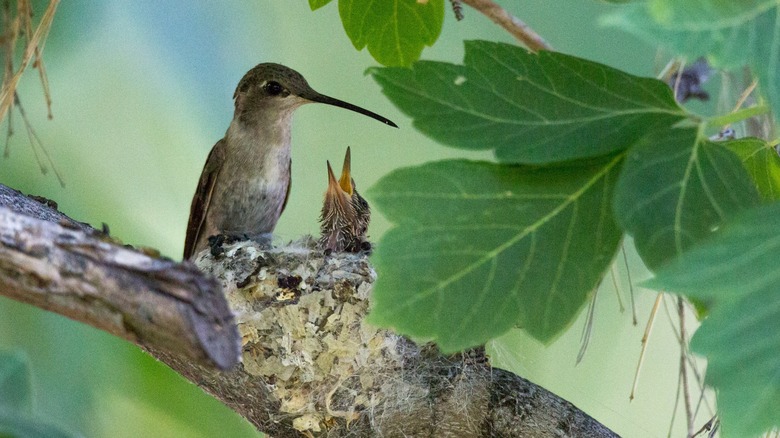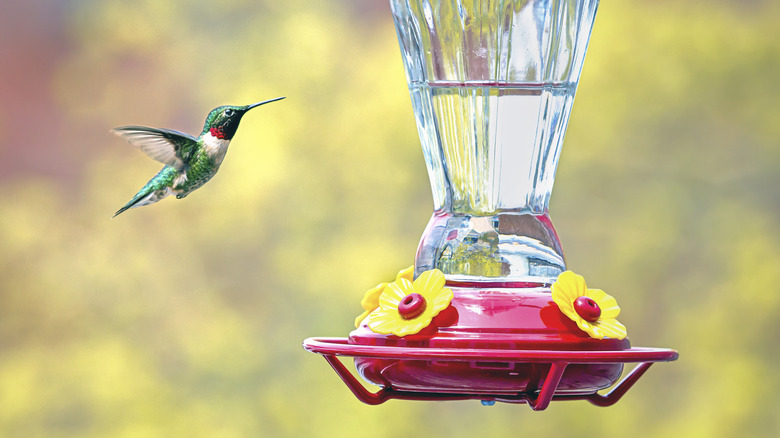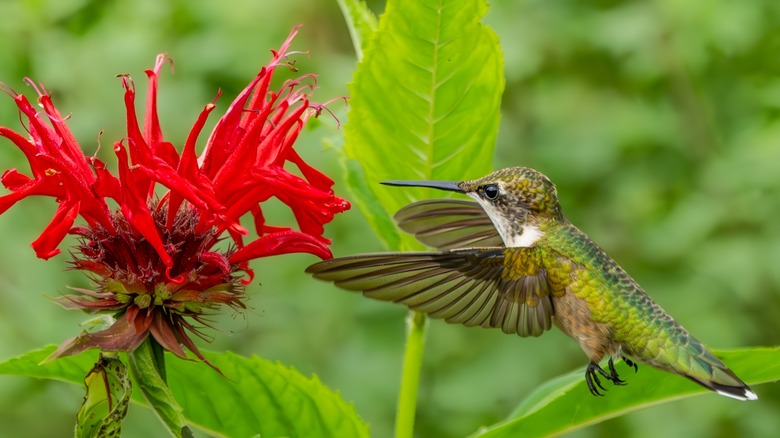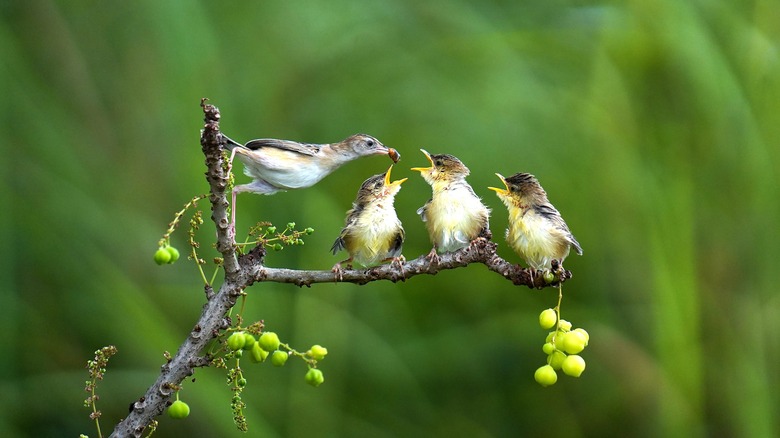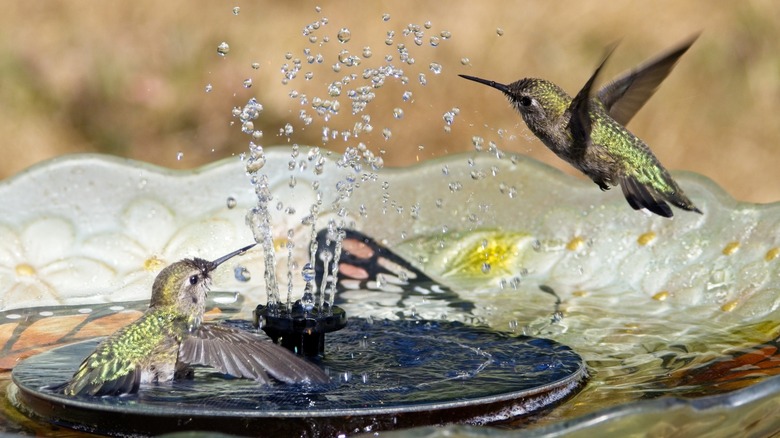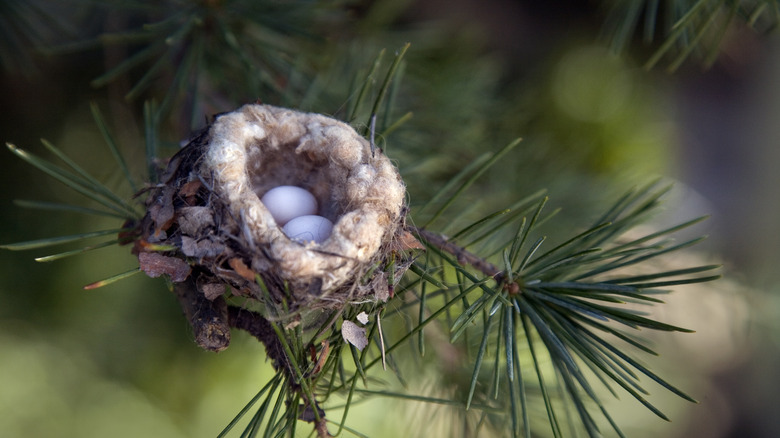The Best Ways To Get More Hummingbirds To Nest In Your Yard
Over 350 varieties of hummingbirds are native to North and South America. They grace nearly every area, from Alaska down to the southernmost tip of South America. There are 15 varieties that can be seen in the United States. No matter which state you live in, you can attract at least one or two types of hummingbirds to your yard and create a nest-friendly habitat for them.
In an exclusive interview with House Digest, Emma Greig, project leader of Cornell Lab of Ornithology's Project Feederwatch, shared some of her favorite tips for making your yard more welcoming to hummingbirds looking for nesting sites. Providing the essentials — food, water, and a safe nesting habitat — is the key here. Timing is also important. If you're in the U.S. or Canada, they only visit for part of the year, so having a good nesting spot set up when they need it is essential to making your yard more inviting.
Put out a hummingbird feeder
The presence of easily-available food will make your yard more attractive to any hummingbirds that are passing through. In her interview with House Digest, Greig noted that, "One way to attract hummingbirds is to put out a hummingbird feeder. The extra source of food will often cause them to hang out in your yard, and may encourage them to nest in your yard too." This is an easy thing to do for just about anyone.
Placing a hummingbird feeder to attract more feathered friends and keeping it full of fresh food is important. These feeders can provide nutrition when flowers (which are hummingbirds' ideal food source) aren't blooming. The best place to hang a feeder is out of direct winds, since wind will make the feeder swing around and spill out the nectar. If you can place it in a shady area, that's preferable to full sun, which can heat up the sugar solution and cause it to spoil quickly.
Hummingbird feeders should be filled with a solution of ¼ cup of sugar to 1 cup of water, which you've boiled and then cooled. Don't add red food coloring to the solution, even though red is known to attract these small birds. And, though it might seem like other sweeteners such as honey, molasses, or brown sugar will work just as well, they won't. Stick to white sugar when making hummingbird food.
Plant hummingbird-friendly plants
Hummingbird feeders are only one part of the equation. To lure beautiful hummingbirds to your yard, you'll also want to focus on creating a garden they'll love. "Another great way to attract hummingbirds is to plant hummingbird-friendly plants," Greig says. "Species such as Bee Balm (also called Monarda) or other red-colored flowers can be a beacon for hummers."
There are plenty of options here. If you have a tiny yard or aren't able to dig garden beds, hanging baskets and container plantings work perfectly. Consider creating a hanging basket planted with nasturtiums, salvia, or lobelia, or a combination of all of them. Zinnias, fuchsias, and cigar plant are a few hummingbird-attracting annuals you can grow in containers. If you have space in your garden, add a few native plants to really draw hummers in. If you're not sure about what will grow best in your area, check out the Audubon Society's native plants database.
Just as importantly, try to always have something blooming in your garden to entice hummingbirds to visit. Everything from spring bulbs, to annuals, perennials, trees, and shrubs count here. This will ensure there's always a source of food, which will make your yard even more attractive as a nesting site. Plus, it makes the garden even prettier for you, too, which is never a bad thing.
Make sure your yard is bug-friendly
Our gardening practices also have an impact on whether our yard will make a good nesting spot for hummingbirds. Greig notes that, "People often forget that hummingbirds eat more than nectar: they also eat bugs! They especially need insects when they are nesting, so keeping your yard insect-friendly is one of the most important ways to make it hummingbird friendly." Since we want to encourage hummingbirds to nest in our yards, we need to make it hospitable to insects as well.
The easiest way to do that is to be less fussy about your landscape. "Don't use pesticides, and consider leaving some areas of your yard 'wild' — for example leave a patch of grass unmowed or unraked," Greig advises. This may go against everything you've ever done as a gardener, but it's worth it. If you're concerned about insect pests decimating your vegetable garden, look into alternative methods. Companion planting and introducing predators and parasites are effective, natural ways to keep the good bugs around and discourage pests. Some of the best bugs for protecting your garden include ground beetles, ladybugs, lacewings, and more.
Another reason to ensure your yard is insect-friendly? One of the primary materials hummingbirds use to build their nests is spider silk. The more spiders you have in your yard building webs, the more readily available spider silk the hummingbirds will have when it comes time to build their nest.
Keep clean water available
Food is important, but it's not the only requirement when a hummingbird is choosing a good nesting spot. "Don't forget water! Hummingbirds will sometimes splash about in a little mister, especially in arid areas, so consider adding a water feature if you want to make your yard especially hummingbird-friendly," Greig shares. The sugar solution provided by hummingbird feeders is for hydration, but they need fresh, clean water for bathing.
You have plenty of options here. Hummingbirds will be attracted to anything from a constant drip to a bubbling fountain or a fine mist. You can even make DIY hummingbird water fountains to add to your yard. Placement is important. You want to make sure the water feature is in a place where the hummers can avoid being snuck up on by cats or other animals, and that there are perches nearby so they can rest after they bathe. Keep the hummingbird bath clean and full of fresh water. The easiest way to clean your birdbath regularly is to soak it in bleach and rinse well.
Provide shrubs and small trees for nesting
With food, water, and bathing essentials out of the way, there's one more important thing hummingbirds need if you want them to nest in your yard: nesting spots! Greig notes that these birds especially need bugs when nesting, so keeping your nesting spot near to where insects hang out is ideal. The best nesting spots for hummingbirds are in small trees and shrubs, preferably placed in less-disturbed areas. Hummingbird nests are tiny – less than one inch in diameter — so they aren't likely to set up shop in huge shade trees. Evergreen or deciduous trees and shrubs with tight branches are most attractive.
While hummingbirds generally prefer to nest in trees and shrubs, you can also build a hummingbird nest box. This is a good option if you don't have trees and shrubs in your yard, or if you've just planted them and they're still a bit sparse. This simple open-platform shelf should be placed around 10 feet off of the ground and out of prevailing winds if possible. There's no guarantee they'll build there, but if you're able to provide the rest of the things they need, they might take advantage of the nesting box.
Keep your hummingbird feeders clean
The last thing anyone wants is to attract hummingbirds and then make them sick. Hummingbird feeders that aren't properly maintained can cause illness and even death. Sugar solution that warms up too much and isn't changed regularly can ferment and spoil, which can cause a bacterial infection. These bacterial infections can cause hummingbirds' tongues to swell up, so they can't eat and end up starving. And they can pass this infection on to their young, leading to possible starvation in their hatchlings as well.
Ideally, hummingbird feeders should be emptied and cleaned every two to three days. In hot weather, you might need to change the solution and clean the feeder daily. However, if you've noticed a bird that seems sick using the feeder, or if you notice that the water is cloudy or starting to grow mold, change the water immediately and give the feeder a thorough cleaning.
The best way to clean a hummingbird feeder is to use hot water and hydrogen peroxide, though you can also use a solution of water and vinegar. Empty the feeder, take it apart, and soak all of the pieces in the solution for a few minutes. Then, using a clean brush, scrub all of the pieces, rinse well with hot water, and set them aside to dry. Once the feeder is dry, you can add fresh sugar solution and hang it in your yard for the hummingbirds to enjoy.
